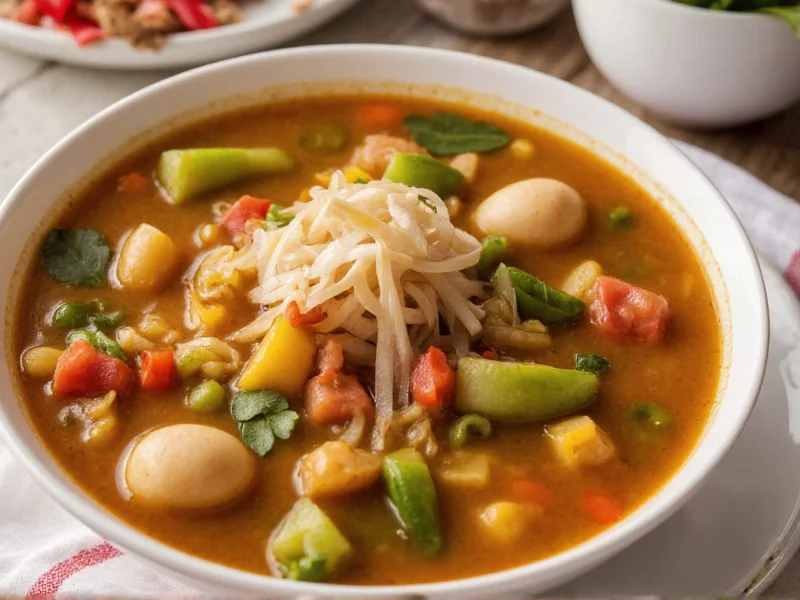The Cultural Heartbeat of Sancocho Soup
Sancocho soup serves as a culinary time capsule preserving centuries of cultural fusion. Originating from Spanish olla podrida (rotten pot) stew traditions, African cooking techniques, and indigenous ingredients, this dish evolved uniquely across Latin America. In the Dominican Republic, sancocho marks special occasions like birthdays and holidays, while Colombians traditionally serve it after cockfights. Puerto Ricans often prepare it during rainy seasons as a communal comfort food. Each country claims their version as the most authentic, reflecting deep cultural pride in this shared culinary heritage.
Essential Ingredients That Define Authentic Sancocho
While regional variations exist, authentic sancocho soup always features these core components:
| Ingredient Category | Common Components | Regional Variations |
|---|---|---|
| Proteins | Chicken, beef ribs, pork ribs, sausage | Dominican: Chicken and beef; Colombian: Beef and pork; Puerto Rican: Chicken and smoked meats |
| Root Vegetables | Yuca, ñame, yautía, potatoes | Venezuelan: More yuca; Panamanian: Adds otoe; Cuban: Uses malanga |
| Additional Vegetables | Plantains, corn on the cob, cabbage | Panamanian: Includes chayote; Colombian: Adds arracacha |
| Aromatics | Garlic, onions, cilantro, culantro, aji peppers | Puerto Rican: More culantro; Dominican: Uses more garlic |
The magic happens when these ingredients simmer together for 2-3 hours, allowing flavors to meld while maintaining distinct textures. Traditional sancocho preparation requires patience—rushing the process compromises the broth's depth. Many families use a special caldero (cast-iron pot) passed through generations, believing it enhances the flavor with each use.
Regional Variations: From Santo Domingo to Bogotá
Understanding the differences between regional sancocho variations reveals the dish's cultural significance:
Dominican Sancocho (Sancocho Dominicano)
Considered by many as the most complex version, Dominican sancocho typically features seven meats (sancocho de siete carnes), including chicken, beef, pork, and Dominican salami. The addition of guandules (pigeon peas) creates sancocho de guandules, a variation often served during Lent. Dominican cooks emphasize the sofrito base of onions, garlic, and bell peppers as essential for authentic flavor.
Puerto Rican Sancocho
Puerto Rican sancocho often features chicken as the primary protein with ajíes dulces (sweet peppers) providing subtle heat. Many families add recaíto (cilantro-based seasoning) and tomato sauce for a richer broth. Unlike other versions, Puerto Rican sancocho frequently includes dumplings (pelau) that absorb the flavorful broth.
Colombian Sancocho
Colombian sancocho varies dramatically by region—coastal versions feature fish and coconut milk, while Andean regions use beef and chicken. The signature sancocho de gallina (hen sancocho) requires slow cooking to tenderize the older bird. Colombians traditionally serve it with ají sauce and avocado on the side, allowing diners to customize heat levels.
Perfecting Your Sancocho Soup Technique
Master authentic sancocho preparation with these professional techniques:
- Layer proteins strategically: Add tougher meats first (beef ribs, pork), then chicken, and delicate ingredients last (plantains, cabbage)
- Control broth clarity: Skim foam during initial boiling for a cleaner broth, or leave it for richer flavor
- Balance starch content: Add root vegetables at different times to prevent mushiness—yuca and ñame first, plantains later
- Season in stages: Add salt after vegetables to prevent toughening meats, finish with fresh cilantro
- Rest before serving: Let sancocho sit 15-20 minutes off heat for flavors to fully integrate
Traditional cooks often make sancocho a day ahead—the flavors deepen overnight, and solidified fat becomes easy to remove from the surface. When reheating, add a splash of water or broth to restore the ideal consistency. Authentic sancocho should have a thick, hearty broth that coats the back of a spoon without being overly starchy.
Serving Traditions and Modern Adaptations
Across Latin America, sancocho soup follows specific serving customs. Dominicans typically serve it with white rice, avocado, and ají sauce on the side. Puerto Ricans often accompany it with pan de agua (water bread), while Colombians prefer it with capillary rice and a cold beer. Many families maintain the tradition of serving sancocho in two courses—first the broth with some vegetables, then the meats and remaining solids.
Modern kitchens have adapted traditional sancocho preparation without sacrificing authenticity. Instant Pot methods reduce cooking time to 45 minutes while maintaining flavor depth. Health-conscious cooks substitute leaner meats and increase vegetable variety while preserving the dish's essence. Freezing portions allows enjoying authentic sancocho without the lengthy preparation—just thaw and reheat with additional broth.
Why Sancocho Soup Endures Across Generations
Sancocho soup survives as more than sustenance—it represents cultural resilience and community. During colonial times, enslaved Africans and indigenous peoples transformed limited ingredients into nourishing meals, creating sancocho's foundation. Today, it bridges generations as elders teach children traditional preparation methods. The dish's adaptability ensures its relevance—whether using traditional wood fires or modern stovetops, the essence remains unchanged. As Latin American communities spread globally, sancocho becomes a portable piece of home, connecting diaspora communities to their roots through shared culinary tradition.











 浙公网安备
33010002000092号
浙公网安备
33010002000092号 浙B2-20120091-4
浙B2-20120091-4